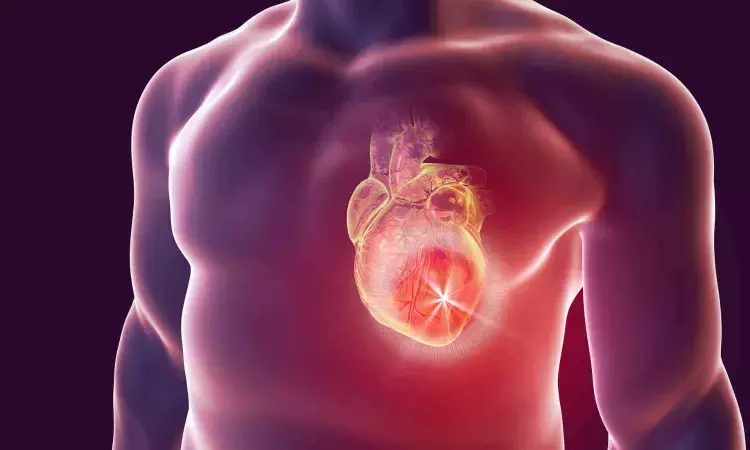- Home
- Medical news & Guidelines
- Anesthesiology
- Cardiology and CTVS
- Critical Care
- Dentistry
- Dermatology
- Diabetes and Endocrinology
- ENT
- Gastroenterology
- Medicine
- Nephrology
- Neurology
- Obstretics-Gynaecology
- Oncology
- Ophthalmology
- Orthopaedics
- Pediatrics-Neonatology
- Psychiatry
- Pulmonology
- Radiology
- Surgery
- Urology
- Laboratory Medicine
- Diet
- Nursing
- Paramedical
- Physiotherapy
- Health news
- Fact Check
- Bone Health Fact Check
- Brain Health Fact Check
- Cancer Related Fact Check
- Child Care Fact Check
- Dental and oral health fact check
- Diabetes and metabolic health fact check
- Diet and Nutrition Fact Check
- Eye and ENT Care Fact Check
- Fitness fact check
- Gut health fact check
- Heart health fact check
- Kidney health fact check
- Medical education fact check
- Men's health fact check
- Respiratory fact check
- Skin and hair care fact check
- Vaccine and Immunization fact check
- Women's health fact check
- AYUSH
- State News
- Andaman and Nicobar Islands
- Andhra Pradesh
- Arunachal Pradesh
- Assam
- Bihar
- Chandigarh
- Chattisgarh
- Dadra and Nagar Haveli
- Daman and Diu
- Delhi
- Goa
- Gujarat
- Haryana
- Himachal Pradesh
- Jammu & Kashmir
- Jharkhand
- Karnataka
- Kerala
- Ladakh
- Lakshadweep
- Madhya Pradesh
- Maharashtra
- Manipur
- Meghalaya
- Mizoram
- Nagaland
- Odisha
- Puducherry
- Punjab
- Rajasthan
- Sikkim
- Tamil Nadu
- Telangana
- Tripura
- Uttar Pradesh
- Uttrakhand
- West Bengal
- Medical Education
- Industry
Decoding the Brain: Study evaluates Patterns of Neuronal Death in Hypoxic-Ischemic Encephalopathy Post-Cardiac Arrest

Recent study investigates the pathophysiology of hypoxic-ischemic encephalopathy (HIE) in patients following cardiac arrest (CA), focusing on selective eosinophilic neuronal death (SEND) across various brain regions. A total of 319 patients who experienced successful resuscitation and underwent brain autopsies were analyzed. Eosinophilic neuronal death was quantified in the cerebral neocortex, hippocampus, basal ganglia, cerebellum, and brainstem, categorized according to previously established HIE severity classifications.
Histopathological Findings
Findings revealed that the mean SEND scores varied significantly by brain region, with the hippocampus exhibiting the highest average SEND of 1.8, followed by the neocortex at 1.4, and the brainstem at 0.9. The results identified four distinctive histopathological patterns of HIE: (I) no/mild SEND across all regions, (II) severe SEND localized predominantly to the hippocampus, (III) severe SEND in the neocortex with preserved brainstem function, and (IV) severe SEND impacting the brainstem accompanied by neocortical injury. Notably, 9.7% of patients exhibited substantial heterogeneity in SEND between different neocortical regions, indicating potential clinical implications for neuroprognosis.
Prevalence of Severe SEND
In the cohort studied, 48.3% of patients displayed severe SEND in at least one brain region, with significant proportions demonstrating severe damage to the neocortex while the brainstem remained relatively unaffected. This spatial distribution underscores the hippocampus's vulnerability, which aligns with previous literature highlighting selective neuronal death patterns following CA.
Variability in SEND Distribution
The inter-regional correlation analysis revealed a predominantly homogeneous SEND distribution across the neocortex. However, a subset of patients indicated substantial regional variation in SEND, challenging the assumption of a uniform HIE pattern following CA. These atypical distributions suggest the necessity for refined neuroprognostic assessments that consider potential nuances in HIE presentations.
Demographic Insights
Demographic data indicated a median patient age of 68, with a higher prevalence of male subjects. Notably, a significant number of patients regained consciousness prior to death, suggesting varying trajectories of neurological recovery linked to the extent of SEND.
Conclusions and Future Directions
The conclusions emphasize the critical need for further investigation into less common HIE patterns and their role in neuroprognostic evaluations. Future research should enable deeper insights into the complex interplay between SEND patterns and clinical outcomes, enhancing predictive accuracy and patient management following CA.
Key Points
- The study analyzes pathophysiological mechanisms of hypoxic-ischemic encephalopathy (HIE) post-cardiac arrest (CA) by examining selective eosinophilic neuronal death (SEND) across brain regions in a cohort of 319 resuscitated patients who underwent brain autopsies, categorizing findings based on established HIE severity classifications.
- Histopathological assessments revealed significant regional variance in mean SEND scores, with the hippocampus showing the highest SEND (1.8), followed by the neocortex (1.4) and brainstem (0.9). Four distinct HIE patterns were identified: (I) no/mild SEND, (II) severe SEND predominantly in the hippocampus, (III) severe neocortical SEND with preserved brainstem, and (IV) severe SEND impacting brainstem and neocortex.
- In this cohort, 48.3% of patients exhibited severe SEND in at least one brain region, with notable neocortical damage often accompanied by relatively intact brainstem function. This finding underscores the susceptibility of the hippocampus to injury in the context of HIE after CA.
- Variability in SEND distribution was observed; while send scores were typically homogeneous across neocortical regions, some patients displayed significant inter-regional differences, suggesting that previous assumptions about uniform HIE patterns need reconsideration. This highlights the complexity of SEND presentations post-CA.
- Demographic analysis revealed a median age of 68 years among subjects, with a notable predominance of males. Additionally, a considerable fraction of patients regained consciousness before death, indicating diverse recovery trajectories linked to the severity and patterns of SEND.
- Conclusions drawn from the study underscore the urgency for further investigations into atypical HIE patterns that could refine neuroprognostic assessments. Future research is recommended to elucidate the relationship between SEND patterns and clinical outcomes, potentially improving predictive models for managing patients after cardiac arrest.
Reference –
C. Endisch et al. (2025). Histopathological Patterns Of Hypoxic-Ischemic Encephalopathy After Cardiac Arrest: A Retrospective Brain Autopsy Study Of 319 Patients.. *Resuscitation*, 110608 . https://doi.org/10.1016/j.resuscitation.2025.110608.
MBBS, MD (Anaesthesiology), FNB (Cardiac Anaesthesiology)
Dr Monish Raut is a practicing Cardiac Anesthesiologist. He completed his MBBS at Government Medical College, Nagpur, and pursued his MD in Anesthesiology at BJ Medical College, Pune. Further specializing in Cardiac Anesthesiology, Dr Raut earned his FNB in Cardiac Anesthesiology from Sir Ganga Ram Hospital, Delhi.


